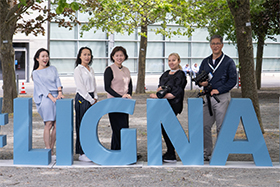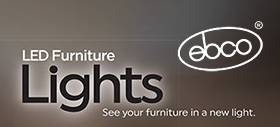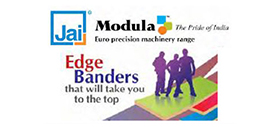Australian architects design for KEEPsakes

Hundreds of timber tiles were painstakingly hand-sewn together, taken apart and reapplied in a time-consuming and complicated exploration of the best way to drape the ‘Lamella’ chair.
Six acclaimed Australian architects were challenged by the American Hardwood Export Council (AHEC) to design new furniture pieces that embody permanence.
AHEC’s latest design collaboration in Australia, ‘KEEP’, was on display until October 4.
AHEC is the leading international trade association for the American hardwood industry.
At the heart of ‘KEEP’ is the use of three American hardwoods: American red oak (Quercus rubra), American hard maple (Acer saccharum) and American cherry (Prunus serotina). These are sustainably grown in the vast hardwood forests of the United States, where growth outpaces harvest.
Curated by David Clark, KEEP explored longevity, craftsmanship and material integrity as an antidote to disposable culture. The designs, which have been crafted from American red oak, cherry and maple – timbers chosen for their beauty, resilience and environmental integrity – underline the importance of good material in the creation of fine furniture.
The resulting pieces were diverse in form and function, yet united by a shared commitment to longevity, craftsmanship and material honesty. According to Clark, the exhibition aimed to counter notions of careless consumption, material disposability, overly complicated supply chains, and the prevalence of waste in contemporary culture.
David Clark’s 35-year career in the interior design industry has helped shape the way we view Australian design. As Editor-in-Chief of Vogue Living Australia (2003-2012) he elevated Australian designers and the publication globally.
In 2016, he was inducted into the Design Institute of Australia Hall of Fame and later appointed to the DIA’s board of directors. He is also an ambassador for Good Design Australia.
Approaching the brief for this project, Rachel Nolan and Patrick Kennedy, Principals of Melbourne-based Kennedy Nolan practice, designed an anthropomorphic console in the form of a creature.
The ‘David’ Console (in American cherry) has a distinctly animal quality about it, with a head, tail and flank, all rendered in different finishes to the timber: scraped, gouged, laminated or coated.
Virginia Kerridge’s ‘Pax’ Table (American cherry) is an interpretation of a traditional woodworking technique that uses butterfly joints to connect two pieces of split timber. In this case, brass joints span across a recessed groove that follows the natural line of the grain in a central section of timber.
This table is designed to be removed from its slotted base, which also comes apart to be flat-packed and more easily transported. The feet of the angular legs are stained a deep red, with brass strips at the very base occasionally capturing glimmers of light.
Richards Stanisich’s ‘Lamella’ Chair (in American maple) was conceived as a covering over an existing found or discarded chair, in this case a nondescript 1980’s metal-framed chair with curvilinear arms. A lamella is a small, thin, plate-like structure usually referenced in biology. It can also be used as a reference to armour.
A chance encounter with Meg Ashforth, a prominent costume designer on films such as Mad Max: Fury Road, who also has an interest in Japanese historical armour, led to a collaboration, a further six weeks of hand sewing and making, and a piece of furniture that encompasses design, craft and art.
The Edition Office Studio’s ‘Twin’ Bench, made from American red oak, is designed as a seat for two that allows plenty of space for each. The architect investigated the process of assembly, in particular the aesthetic expression that comes from holding a curve against a straight piece of structure, and how joints might slip past each other. The back of this bench expresses that most clearly.
Neil Durbach’s ‘Small Slide’ Table (American red oak) and ‘Einstein’s Hat’ Vase (American red oak and cherry). The side table is a diminutive and curious interpretation of a more conventional sliding table.
The slide is just a few centimetres, enough to reveal a metallic finish in the separation, and cast shadows “that seem to be like smiles”. The plan shape is conceived as being a more geometric version of a cross-section of a tree.
The 13-sided outline for the vase is a shape provided by geometry that was discovered by a group of mathematicians in 2022-23. It is an ’a-periodic tiling’, a shape that can be put together without ever repeating the overall pattern.
The internal line of the vase is looser. This is a prototypical experiment in timber, a material that is not conducive to holding water. The interior, still developing, is ultimately to be a highly reflective metallic.
Lineburg Wang’s ‘Pedal’ Lamp (also in American cherry) is a moveable piece, in balance and counter-balance and operability. The foot pedal mechanism of a pedestal bin opens a ‘block’ of timber at the top and turns on a hidden light source. The mechanisms of movement and opening are all hidden and embedded internally.
The hinges are beautifully constructed out of timber. A subtle curve to the face of the light is only noticeable up close and revealed in shadows when the lid is open. The interior face of the lid has a high gloss finish to be as reflective as possible, enhancing the glow of light from the top of the timber monolith.
For more information, visit: www.americanhardwood.org, or follow it on @ahec_india.
Comments

- European symposium highlights formaldehyde emission limits
- Egger adopts holistic approach to waste management
- Taiwan’s Woodworking Machinery Industry Captivates Global Media on Opening Day of LIGNA 2025
- Coming of age of sustainability
- Intelligent packing line, sander from Woodtech
- Ornare introduces 5 new leather decors
- Richfill Edge Coat offers safer plywood finishing
- Jai’s Optimus range stays ahead of the curve
- Merino’s Acrolam sets new benchmarks in elegance
- Pytha 3D-CAD: where precision meets production
- Raucarp edge bands: simple, affordable
- Greenlam scores a 1st: High Quality Product Award
- Häfele turns space solutions provider
- Hettich bets on intelligent motion for evolving interiors
- Praveedh taking desi innovation to the global stage
- Turakhia shows off its Natural Veneers range
- Egger continues to ‘inspire, create, grow’
- Blum turns heads with new drawer, hinge systems
- FSC benchmarking responsible forestry
- At 100, Festool powers new solutions
- Door manufacturing on cusp of transformation
- AI-powered crib sings a universal lullaby
- In Full Bloom: Top brass at Blum takes a shot at burgeoning India market
- Elegant mathematics is bending the future of design
- Wood fibres weave new textile yarn
- Rolls-Royce icon: ‘most intricate woodwork ever’
- Felder’s long-term view to achieving excellence
- Tech in the future of furniture manufacturing
- Exports from India on horizon: Juergen Koeppel, CEO, Leitz Tooling
- Pfleiderer adds value with digital ‘structure finder’
- Australian architects design for KEEPsakes
- Jump shot! Crafting the ultimate pool table
- Apple adopts CLT to cut building emissions
- Sustainable design at Hotel Hábitat 2025
- Vecoplan tailors waste wood processing at Schaffer Holz
- Dealer engagement goes digital
- How to refinish wood decks like a pro
- IWMMTA makes strong beginning in the East
- Feria Hábitat weathers unusual Spanish storm
- Interzum Guangzhou 2026: materials defining the future
- Forum Italy: Beyond Furniture, Towards the Future
- CIFF Shanghai: hub of design, innovation
- Interzum Jakarta debuts with strong connect
- DAIC to showcase Kerala’s prowess this December
- Events Calendar: Industry fairs to visit


































